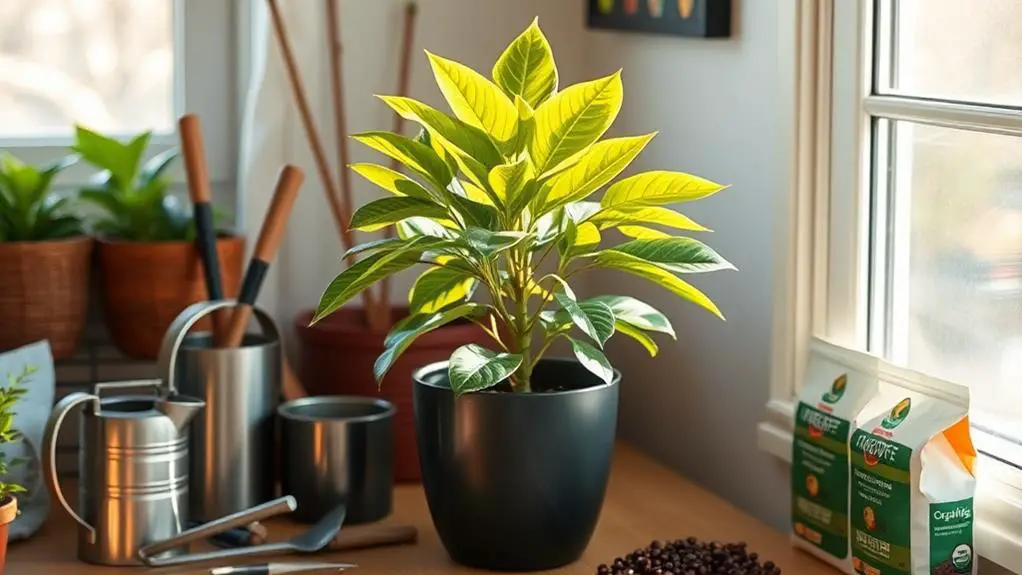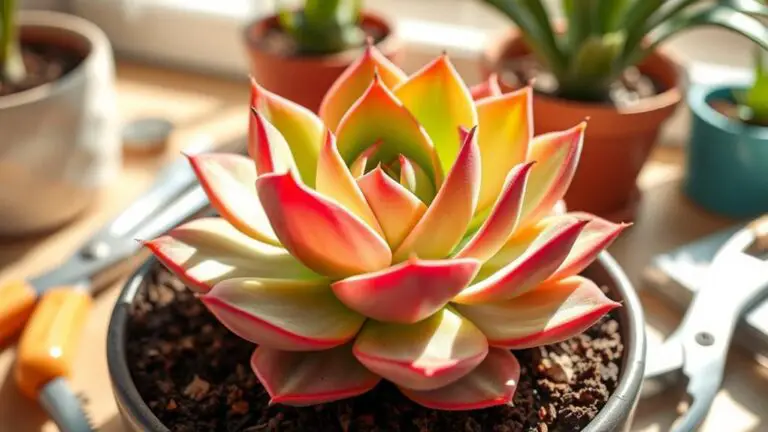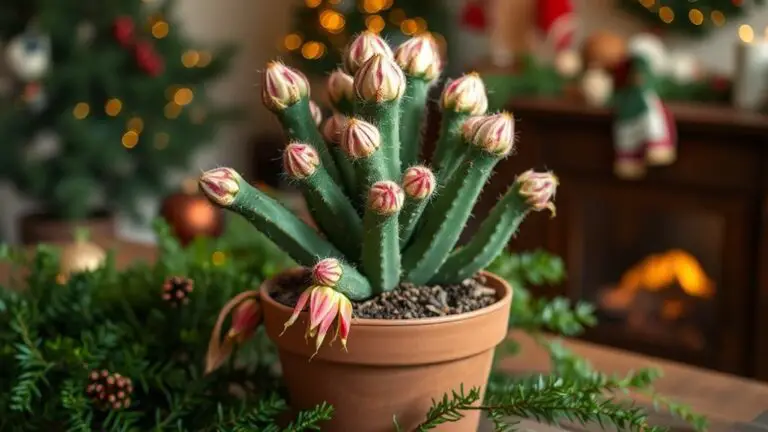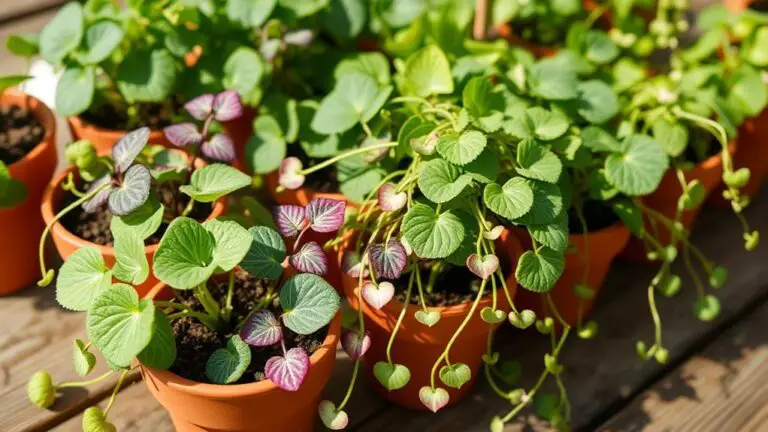10 Steps to Grow and Care for Your Coffee Plant at Home
Starting your journey to grow and care for a coffee plant at home involves selecting the right variety, such as C. arabica for its rich flavor or C. arabica Nana for limited spaces. You'll need to provide bright indirect sunlight, maintain a specific humidity level, and use rich, slightly acidic soil. Water consistently and fertilize monthly during the growing season to guarantee your plant thrives. But how do you handle pruning, propagation, and pest management effectively? And what are the tricks to encourage blooming? Let's explore each of these steps to guarantee your coffee plant flourishes.
Choosing the Right Coffee Plant
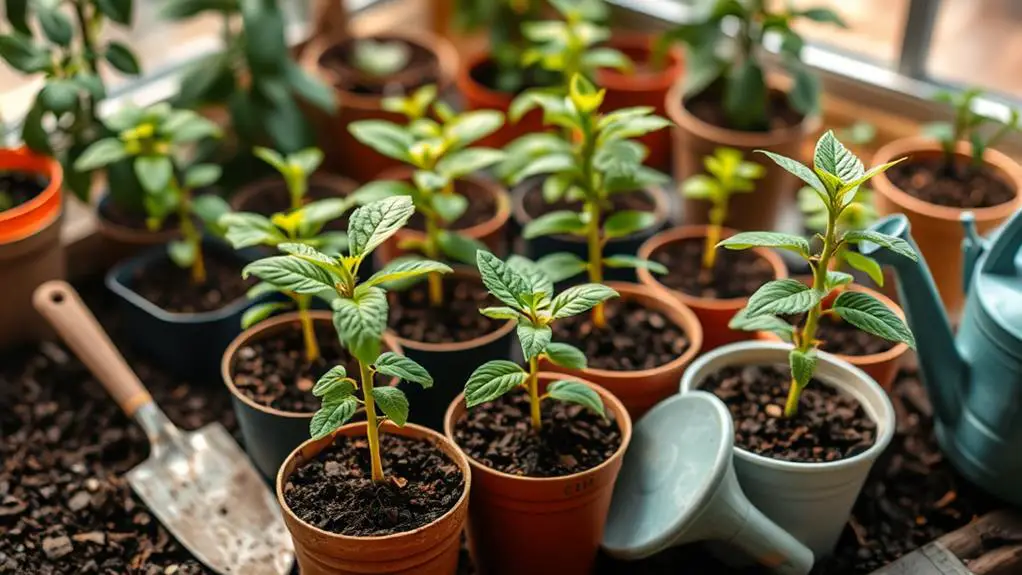
When you're thinking about growing a coffee plant at home, selecting the right variety is essential.
C. arabica is a popular choice due to its rich flavor profile and its ability to thrive indoors. For limited space, consider the C. arabica Nana, a dwarf variety that only grows to about 12 inches tall. It's perfect for small areas.
If you need a hardier plant, C. canephora (robusta) offers a stronger taste but needs more care with humidity and light.
C. liberica is for adventurous growers, boasting unique characteristics and higher caffeine content.
Ideal Growing Conditions

How can you guarantee your coffee plant thrives at home? Start by ensuring it's grown in bright indirect sunlight. Direct sun can brown the leaves, so place your plant near a window with filtered light.
Keep the soil consistently moist, but avoid waterlogging to prevent root rot. High humidity is a must; aim for 50% or higher. Use a humidifier or mist the leaves daily.
Your coffee plant will also need slightly acidic, rich potting soil to support its growth. A peat-based mix works well.
Maintain daytime temperatures between 70-80°F and nighttime temperatures between 65-70°F. Following these tips will help you create the ideal growing conditions for your coffee plant.
Proper Watering Techniques
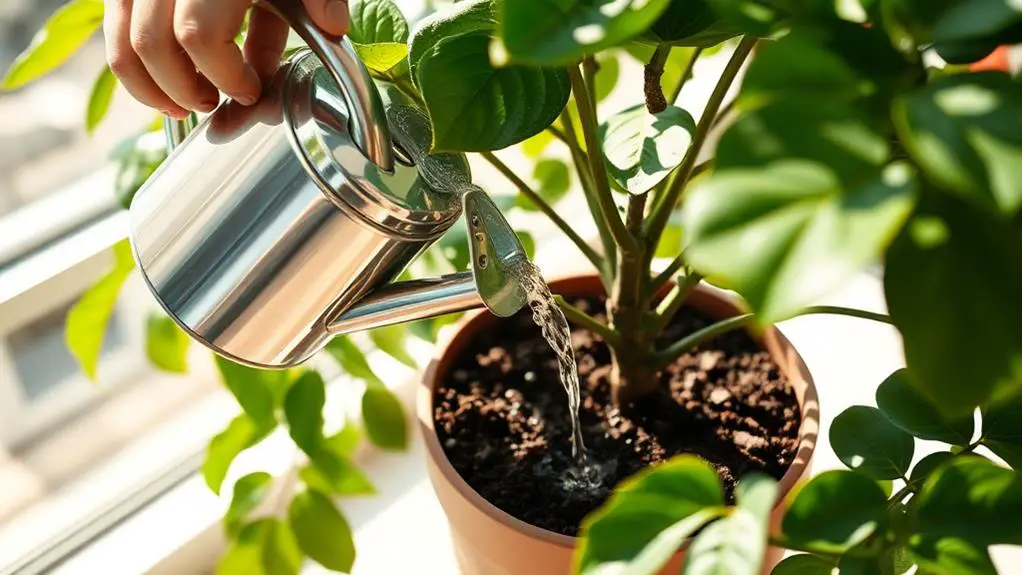
Ensuring your coffee plant gets the right amount of water is essential for its health and growth. Water your plant when about 25% of the soil volume is dry to keep it moist without overwatering.
Make sure your pot has drainage holes to prevent waterlogging, which can cause root rot. During spring and summer, water more often since the plant needs more moisture due to higher temperatures and humidity.
In winter, reduce watering because the plant goes dormant; keep an eye on soil moisture to avoid excess water.
Regularly check the humidity around your plant. If it's not 50% or higher, mist the leaves or use a humidifier.
Using well-draining potting soil helps maintain proper soil moisture.
Soil and Fertilization
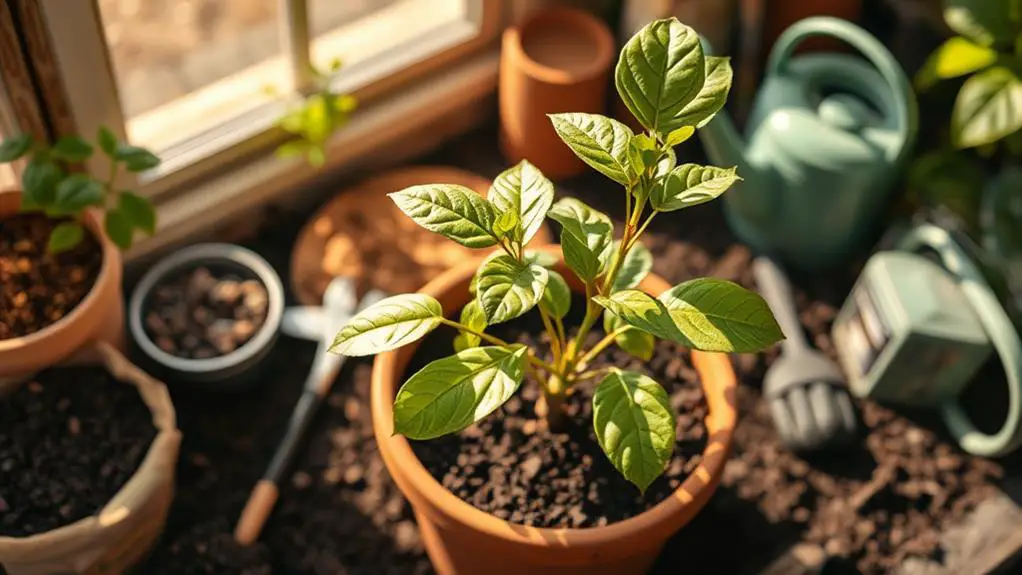
A coffee plant's success starts with the right soil and fertilization. Use rich, peat-based, slightly acidic potting soil with a pH of 6.0 to 6.5. This helps your plant absorb nutrients effectively.
Keep the soil consistently moist but not waterlogged. Water when the top 25% of the soil dries out. Fertilize monthly in spring and summer using a balanced 10-10-10 fertilizer, diluting it to avoid over-fertilization.
Check regularly for nutrient deficiencies to adjust your fertilization routine as needed. Every 2-3 years, consider repotting your coffee plant. Use a loam-based, peat-free compost and move to a pot one size larger to support root growth.
Following these steps guarantees your coffee plant stays healthy and thriving.
Maintaining Humidity Levels
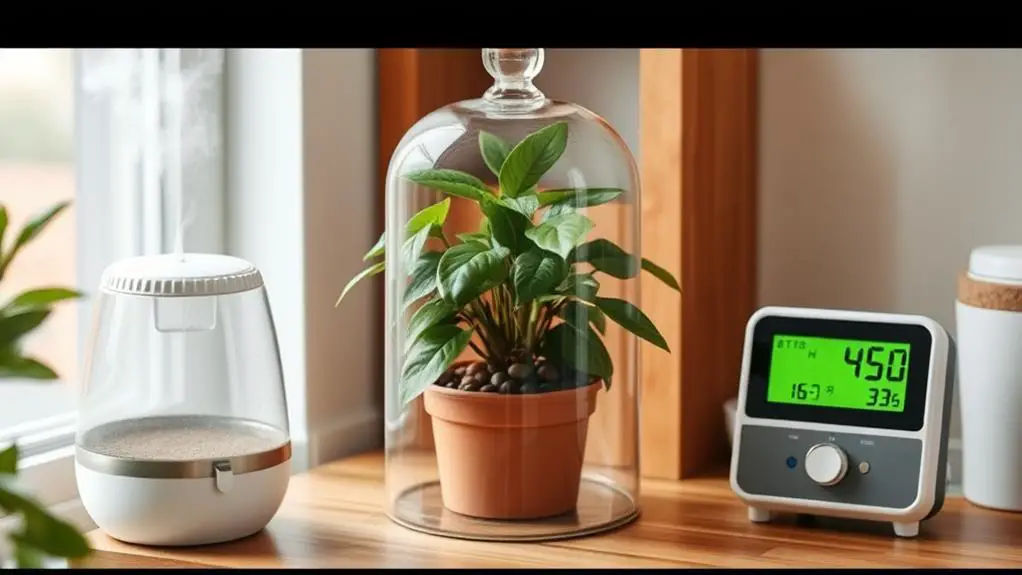
To keep your coffee plant happy, maintaining the right humidity level is key.
Use a humidifier or place a tray with water and pebbles under the plant to create a moist environment.
Regularly mist the leaves, but be careful not to overdo it, and consider grouping your coffee plant with other humidity-loving plants for the best results.
Using a Humidifier
Maintaining the right humidity levels is essential for the health of your coffee plant, especially in dry indoor environments. Coffee plants thrive in humidity levels of 50% or higher.
Using a humidifier can help maintain the consistent moisture your plant needs. Aim for 60-70% humidity to prevent leaf browning and promote healthy growth. Place the humidifier near your coffee plant, but not too close, to avoid overly saturated leaves.
Regularly monitor the humidity levels with a hygrometer, especially during winter when indoor heating dries the air. In addition to the humidifier, consider misting the leaves daily to increase humidity and create a revitalizing environment.
Following these steps will help your coffee plant flourish.
Regular Misting Routine
Implementing a regular misting routine is key to maintaining the high humidity levels that coffee plants crave. Coffee plants thrive in humidity levels of 50% or higher, so misting their leaves daily is essential.
This is especially important during dry winter months when indoor air is less humid. Use distilled water for misting to avoid mineral buildup that can harm the plant. Lightly mist the leaves, ensuring no water accumulates in the leaf axils to prevent fungal diseases.
Regular misting helps prevent browning and promotes healthy growth. For an extra boost in humidity, place your coffee plant on a tray filled with pebbles and water.
This simple routine will keep your plant happy and thriving.
Grouping With Plants
Grouping your coffee plant with other humidity-loving plants like ferns or peace lilies is a fantastic way to create a microenvironment that meets its high humidity needs.
Coffee plants thrive in humidity levels of 50% or higher. By grouping them together, you'll guarantee they get the moisture they crave.
Placing a tray of pebbles filled with water beneath your plants can help maintain these levels as the water evaporates, increasing the surrounding moisture. Regular misting can also boost humidity and prevent browning leaves.
Just remember, avoid pairing coffee plants with drought-tolerant species, which have different moisture needs. Grouping can also improve air circulation, reducing fungal disease risks.
This guarantees your coffee plants stay healthy and happy.
Pruning Best Practices
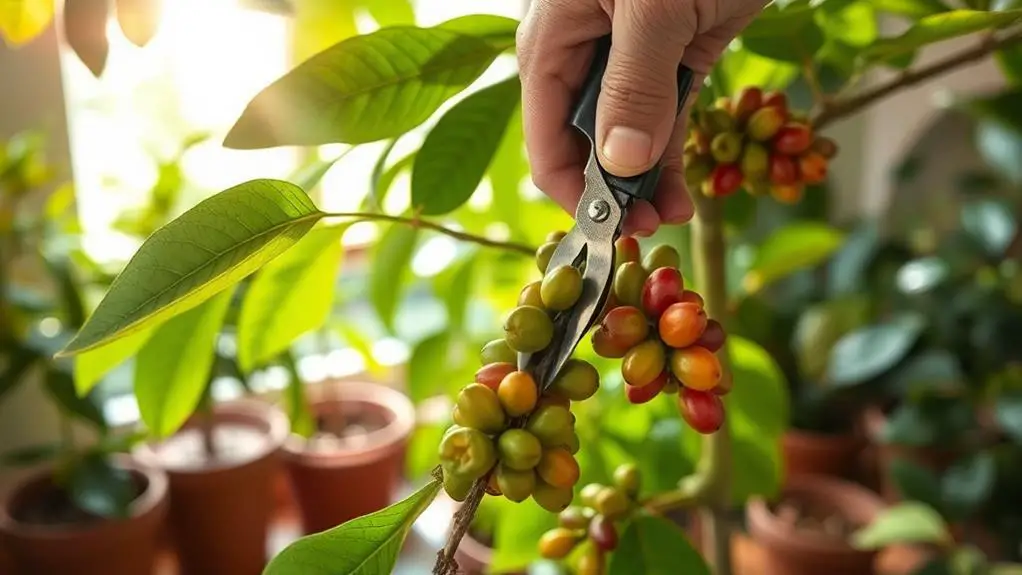
Pruning your coffee plant every spring is crucial to maintain its shape and encourage bushiness.
Use sterilized, sharp shears to remove dead branches and lower leaves. This helps stimulate dense growth and improve air circulation. Proper pruning reduces the risk of fungal diseases and pest infestations.
Make cuts at a 45-degree angle about ¼ inch above a leaf joint. Aim to remove no more than one-third of the plant at a time to avoid stressing it.
This practice guarantees your coffee plant continues to thrive. By keeping your plant well-pruned, you'll support its overall health and growth, creating a lush and vibrant addition to your home.
Effective Propagation Methods
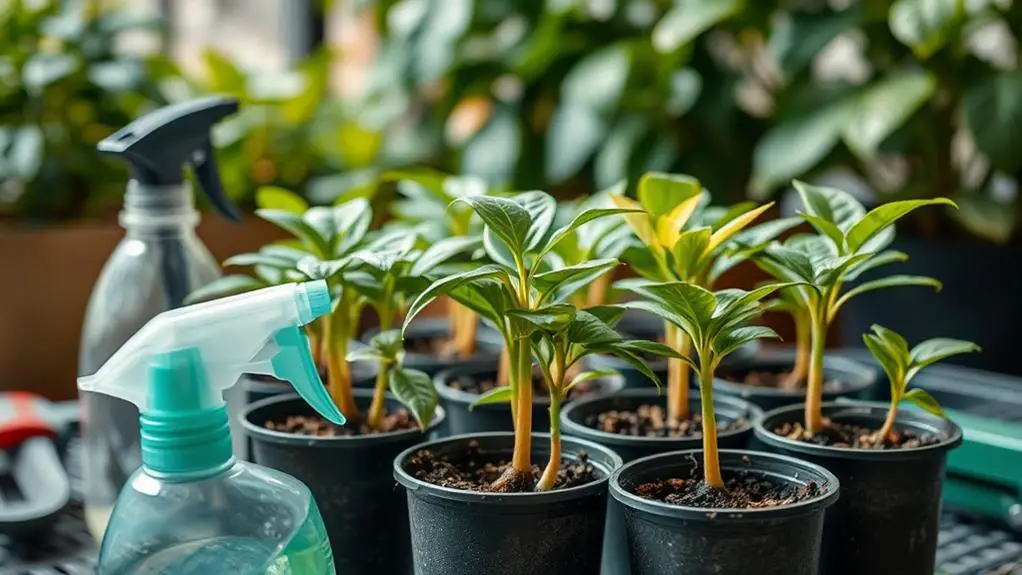
Propagating coffee plants at home can be both rewarding and straightforward with the right techniques.
To propagate a coffee plant quickly, use stem cuttings. Take 8-10 inch cuttings in early summer, dip the cut end in rooting hormone, and plant in damp, well-draining potting mix. Cover with a plastic dome to maintain humidity.
For seed germination, start with ripe cherries, wash and dry the seeds, soak them for 24 hours, then plant them ¼ inch deep in well-draining potting mix.
Keep the soil moist but not waterlogged. Germination takes 6-8 weeks; keep temperatures warm, around 70-80°F. Guarantee seedlings get bright indirect light and monitor closely for pests and diseases to encourage healthy growth.
Encouraging Blooms
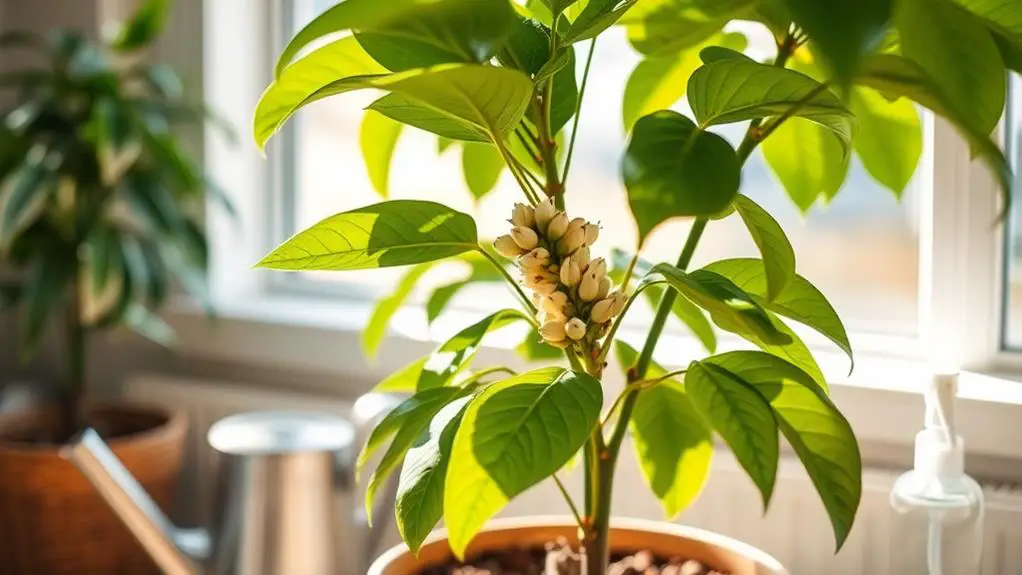
Once you've successfully propagated your coffee plant, the next step is to encourage it to bloom. Coffee plants typically start blooming three to five years after planting, with flowers appearing in April and May if conditions are right.
Reduce watering in the winter to mimic dormancy. Guarantee your plant receives bright, indirect light, as insufficient light can hinder blooming.
Fertilize monthly during the growing season with a balanced fertilizer to support healthy growth and flowering. Maintain humidity levels above 50% to reduce stress, as low humidity can affect blooming.
Keep a consistent temperature and monitor your plant regularly. By creating these ideal conditions, you'll help your coffee plant flourish and produce beautiful blooms.
Common Pests and Diseases
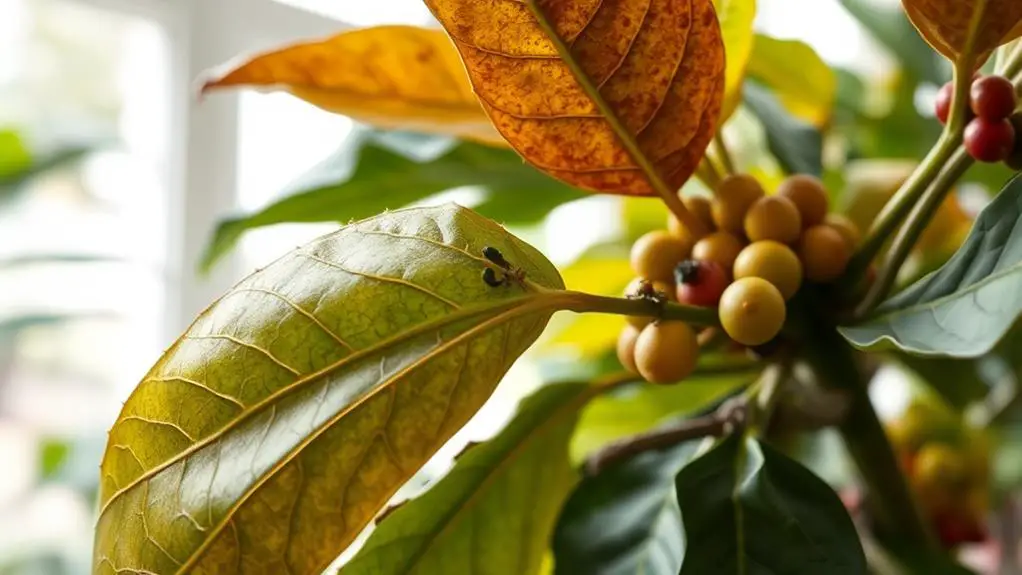
When caring for your coffee plant, you'll need to watch out for common pests like mealybugs, aphids, and red spider mites, which can harm your plant's leaves and overall health.
Check for signs like visible insects, webbing, or mottled foliage, and take action immediately if you spot any.
Fungal diseases, such as leaf spot, can cause brown spots on the leaves, so trim affected leaves and improve air circulation to keep your plant healthy.
Identifying Pest Infestations
A healthy coffee plant can be a source of pride, but vigilant care is essential to keep it thriving. Regular inspection helps catch pests like mealybugs, aphids, and red spider mites early. Look for mealybugs' white, cotton-like clusters, aphids on new growth, and red spider mites' leaf discoloration and fine webs. Fungal diseases, such as leaf spot, can also appear. Early detection prevents extensive damage. Here's a quick guide:
| Pest/Disease | Signs |
|---|---|
| Mealybugs | White, cotton-like clusters |
| Aphids | Small green/black insects |
| Red Spider Mites | Stippling, fine webs |
| Fungal Diseases | Brown leaf spots |
Maintain good air circulation and remove affected foliage. Your coffee plant will thank you!
Treating Fungal Diseases
Fungal diseases can quickly compromise the health of your coffee plant if not addressed promptly. Leaf spot, which causes brown spots on leaves, is a common issue.
Start by removing affected leaves and improving air circulation. Regularly inspect your plant, especially in humid conditions, and keep the leaves dry to reduce risk.
Treat infections with fungicidal sprays or organic solutions like neem oil, following package instructions. Maintaining proper humidity levels above 50% prevents fungal diseases, as dry air can stress the plant.
Confirm your coffee plant is in well-draining soil to avoid waterlogging and root rot. By taking these steps, you'll keep your coffee plant healthy and vibrant.
Preventing Leaf Browning
Treating fungal diseases is just one part of maintaining a healthy coffee plant, but preventing leaf browning requires attention to several other factors.
First, keep humidity levels above 50% and mist your coffee plants regularly to avoid leaf browning. Inspect your plant often for pests like mealybugs and red spider mites, which can damage leaves.
Improve air circulation and remove affected leaves to combat fungal issues like leaf spot. Avoid overwatering to prevent root rot; let the soil dry halfway before watering again.
Also, guarantee your plant gets bright indirect sunlight to prevent leaf scorch. By balancing these elements, you'll help your coffee plant thrive and keep its leaves lush and green.
Troubleshooting Plant Issues
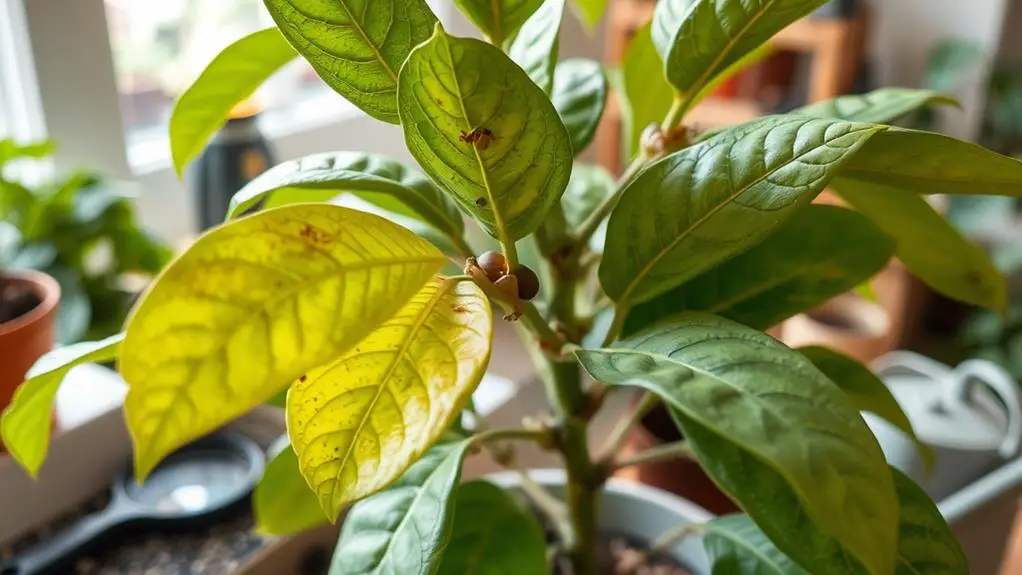
When growing a coffee plant at home, you might encounter various issues that can affect its health and appearance.
If you see brown leaves, it's likely due to insufficient humidity. Keep levels above 50% by misting daily or using a humidifier. Make certain your plant gets bright indirect sunlight to thrive.
For pests like mealybugs and red spider mites, use insecticidal soap or neem oil. Overwatering can cause root rot, so let the soil dry halfway before watering again, and make certain proper drainage.
Nutrient deficiencies may stunt growth; use a balanced fertilizer monthly in spring and summer.
Regularly inspect and care for your coffee plant, and you'll enjoy a healthy, vibrant plant.
Frequently Asked Questions
How to Care for an Indoor Coffee Plant?
Place your coffee plant in bright, indirect light. Water when 25% of the soil dries out. Keep humidity high by misting daily. Fertilize monthly in spring and summer, and inspect regularly for pests to guarantee health.
How Do You Grow Coffee Step by Step?
Start by choosing a healthy coffee seed or seedling. Plant it in rich, peat-based soil. Keep the soil moist but avoid waterlogging. Guarantee bright, indirect sunlight and maintain warm temperatures. Prune regularly and fertilize monthly.
How Do You Grow a Coffee Tree at Home?
You'll need bright, indirect light and temperatures between 65-80°F. Use peat-based, acidic soil, and water when the top 25% is dry. Maintain humidity above 50%, prune in spring, and propagate with stem cuttings or seeds.
How Often Should I Water My Coffee Plant?
Water your coffee plant when the top 25% of the soil feels dry. In spring and summer, water more frequently. During winter, let the soil dry out more between sessions. Always guarantee the pot has drainage holes.
Conclusion
You've got this! Growing a coffee plant at home might seem challenging, but with these steps, you'll be well on your way. Remember to choose the right plant, give it plenty of indirect sunlight, and keep the humidity up. Water it regularly, use good soil, and don't forget to fertilize. Keep an eye out for pests and prune when needed. With a little care, your coffee plant will thrive. Happy gardening!

